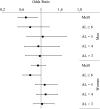Higher adherence to a diet score based on American Heart Association recommendations is associated with lower odds of allostatic load and metabolic syndrome in Puerto Rican adults
- PMID: 24005611
- PMCID: PMC3796346
- DOI: 10.3945/jn.113.180141
Higher adherence to a diet score based on American Heart Association recommendations is associated with lower odds of allostatic load and metabolic syndrome in Puerto Rican adults
Abstract
A score based on diet and lifestyle recommendations from the AHA has been associated with cardiovascular risk factors. We aimed to assess whether the diet components alone were associated with metabolic syndrome (MetS) and allostatic load (AL; a composite measure of 10 physiologically dysregulated variables). The diet score ranged from 0 to 90 and included intake components for dietary fats, fruits and vegetables, whole grains, salt, added sugars, and alcohol and was tested in a cross-sectional analysis of 1318 Puerto Rican adults (aged 45-75 y; 72% women) living in Boston, MA. The mean ± SD diet score was 28.0 ± 9.9 for men and 30.0 ± 10.1 for women. Replicating findings from a previous study in this cohort that used both the diet and lifestyle components, we observed associations between the diet-only score and insulin, waist circumference, and HDL cholesterol. We found novel significant associations between the continuous diet score and AL components, namely an inverse association with urinary cortisol and a positive association with serum dehydroepiandrosterone sulfate in women as well as an inverse association with urinary norepinephrine in men (all P < 0.05). In multinomial logistic regression, every 10 AHA diet score units were associated with 22% (95% CI: 1, 38; P = 0.043) lower odds of having ≥6 (vs. ≤2) dysregulated AL components in women. In men, every 10 diet score units were associated with lower odds of MetS (OR: 0.69; 95% CI: 0.52, 0.93; P = 0.016). Following AHA recommendations for a healthy diet may protect against the development of components of MetS and AL in Puerto Rican adults.
Conflict of interest statement
Author disclosures: J. Mattei, S. Bhupathiraju, and K. L. Tucker, no conflicts of interest.
Figures

Similar articles
-
A Healthy Lifestyle Score Is Associated with Cardiometabolic and Neuroendocrine Risk Factors among Puerto Rican Adults.J Nutr. 2015 Jul;145(7):1531-40. doi: 10.3945/jn.114.206391. Epub 2015 May 6. J Nutr. 2015. PMID: 25948783 Free PMC article.
-
Adherence to the 2006 American Heart Association Diet and Lifestyle Recommendations for cardiovascular disease risk reduction is associated with bone health in older Puerto Ricans.Am J Clin Nutr. 2013 Nov;98(5):1309-16. doi: 10.3945/ajcn.112.056267. Epub 2013 Sep 18. Am J Clin Nutr. 2013. PMID: 24047918 Free PMC article.
-
A meat, processed meat, and French fries dietary pattern is associated with high allostatic load in Puerto Rican older adults.J Am Diet Assoc. 2011 Oct;111(10):1498-506. doi: 10.1016/j.jada.2011.07.006. J Am Diet Assoc. 2011. PMID: 21963016 Free PMC article.
-
Adherence index based on the AHA 2006 diet and lifestyle recommendations is associated with select cardiovascular disease risk factors in older Puerto Ricans.J Nutr. 2011 Mar;141(3):460-9. doi: 10.3945/jn.110.133603. Epub 2011 Jan 26. J Nutr. 2011. PMID: 21270369 Free PMC article.
-
Dietary Assessment Tools and Metabolic Syndrome: Is It Time to Change the Focus?Nutrients. 2022 Apr 8;14(8):1557. doi: 10.3390/nu14081557. Nutrients. 2022. PMID: 35458121 Free PMC article. Review.
Cited by
-
Diet Quality and Its Association with Cardiometabolic Risk Factors Vary by Hispanic and Latino Ethnic Background in the Hispanic Community Health Study/Study of Latinos.J Nutr. 2016 Oct;146(10):2035-2044. doi: 10.3945/jn.116.231209. Epub 2016 Sep 7. J Nutr. 2016. PMID: 27605403 Free PMC article.
-
Longitudinal Changes in Allostatic Load during a Randomized Church-based, Lifestyle Intervention in African American Women.Ethn Dis. 2019 Apr 18;29(2):297-308. doi: 10.18865/ed.29.2.297. eCollection 2019 Spring. Ethn Dis. 2019. PMID: 31057315 Free PMC article. Clinical Trial.
-
A Healthy Lifestyle Score Is Associated with Cardiometabolic and Neuroendocrine Risk Factors among Puerto Rican Adults.J Nutr. 2015 Jul;145(7):1531-40. doi: 10.3945/jn.114.206391. Epub 2015 May 6. J Nutr. 2015. PMID: 25948783 Free PMC article.
-
Longitudinal Associations between Monetary Value of the Diet, DASH Diet Score and the Allostatic Load among Middle-Aged Urban Adults.Nutrients. 2019 Oct 3;11(10):2360. doi: 10.3390/nu11102360. Nutrients. 2019. PMID: 31623373 Free PMC article.
-
Depressive symptoms and allostatic load have a bidirectional association among Puerto Rican older adults.Psychol Med. 2022 Oct;52(14):3073-3085. doi: 10.1017/S0033291720005139. Epub 2021 Jan 14. Psychol Med. 2022. PMID: 33443008 Free PMC article.
References
-
- Lichtenstein AH, Appel LJ, Brands M, Carnethon M, Daniels S, Franch HA, Franklin B, Kris-Etherton P, Harris WS, Howard B, et al. Diet and lifestyle recommendations revision 2006: a scientific statement from the American Heart Association Nutrition Committee. Circulation. 2006;114:82–96. - PubMed
-
- Collazo SG, Ryan CL, Bauman KJ. Profile of the Puerto Rican population in United States and Puerto Rico: 2008. Dallas, TX: U.S. Census Bureau, Housing and Household Economic Statistics Division; 2010. Available from: www.census.gov/hhes/socdemo/education/data/acs/paa2010/Collazo_Ryan_Baum....
-
- Hajat A, Lucas JB, Kington R. Health outcomes among Hispanic subgroups: data from the National Health Interview Survey, 1992–95. Adv Data. 2000;15(Supp. 1):1–14. - PubMed
-
- Li C, Balluz LS, Okoro CA, Strine TW, Lin JM, Town M, Garvin W, Murphy W, Bartoli W, Valluru B. Surveillance of certain health behaviors and conditions among states and selected local areas—Behavioral Risk Factor Surveillance System, United States, 2009. MMWR Surveill Summ. 2011;60:1–250. - PubMed
-
- Daviglus ML, Talavera GA, Aviles-Santa ML, Allison M, Cai J, Criqui MH, Gellman M, Giachello AL, Gouskova N, Kaplan RC, et al. Prevalence of major cardiovascular risk factors and cardiovascular diseases among Hispanic/Latino individuals of diverse backgrounds in the United States. JAMA. 2012;308:1775–84. - PMC - PubMed
Publication types
MeSH terms
Substances
Grants and funding
LinkOut - more resources
Full Text Sources
Other Literature Sources
Medical

